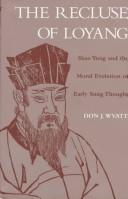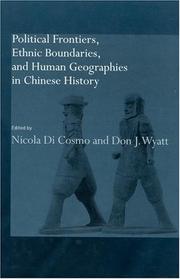| Listing 1 - 8 of 8 |
Sort by
|

ISBN: 0824817559 Year: 1996 Publisher: Honolulu University of Hawaii press
Abstract | Keywords | Export | Availability | Bookmark
 Loading...
Loading...Choose an application
- Reference Manager
- EndNote
- RefWorks (Direct export to RefWorks)
S12/0430 --- S12/0234 --- China: Philosophy and Classics--Neo-Confucianists: general and Song (including lixue 理學) --- China: Philosophy and Classics--Chinese philosophy: Song, Liao, Jin --- Philosophy, Chinese --- Shao, Yung, --- Thiệu, Ung, --- Shōyō, --- 邵雍, --- Shao, Kangjie, --- Shao, Kʻang-chieh, --- Thiệu, Khang Tiết, --- So, Kangjŏl, --- 邵康節, --- 邵康节, --- 소 강절, --- Shao, Yaofu, --- Shao, Yao-fu, --- 邵尧夫, --- Anlexiansheng, --- An-le-hsien-sheng, --- 安乐先生, --- Wuming gong, --- Wu-ming kung, --- 无名公,
Book
ISBN: 1009020234 1009020439 1009007009 1009001701 Year: 2022 Publisher: Cambridge : Cambridge University Press,
Abstract | Keywords | Export | Availability | Bookmark
 Loading...
Loading...Choose an application
- Reference Manager
- EndNote
- RefWorks (Direct export to RefWorks)
In premodern China, Korea, Japan, and Vietnam, just as in the far less culturally cohesive countries composing the West of the Middle Ages, enslavement was an assumed condition of servitude warranting little examination, as the power and profits it afforded to the slaver made it a convention pursued unreflectively. Slavery in medieval East Asia shared with the West the commonplace assumption that nearly all humans were potential chattel, that once they had become owned beings, they could then be either sold or inherited. Yet, despite being representative of perhaps the most universalizable human practice of that age, slavery in medieval East Asia was also endowed with its own distinctive traits and traditions. Our awareness of these features of distinction contributes immeasurably to a more nuanced understanding of slavery as the ubiquitous and openly practiced institution that it once was and the now illicit and surreptitious one that it intractably remains.
Social History --- History --- Slavery
Book
ISBN: 9781009007009 9781009001700 Year: 2022 Publisher: Cambridge Cambridge University Press
Abstract | Keywords | Export | Availability | Bookmark
 Loading...
Loading...Choose an application
- Reference Manager
- EndNote
- RefWorks (Direct export to RefWorks)
Book
ISBN: 0824874668 0585327645 Year: 1996 Publisher: Honolulu, Hawaii : University of Hawai'i Press,
Abstract | Keywords | Export | Availability | Bookmark
 Loading...
Loading...Choose an application
- Reference Manager
- EndNote
- RefWorks (Direct export to RefWorks)
Book
ISBN: 9780812203585 Year: 2012 Publisher: Philadelphia
Abstract | Keywords | Export | Availability | Bookmark
 Loading...
Loading...Choose an application
- Reference Manager
- EndNote
- RefWorks (Direct export to RefWorks)
Book
ISBN: 9780824874667 Year: 2022 Publisher: Honolulu
Abstract | Keywords | Export | Availability | Bookmark
 Loading...
Loading...Choose an application
- Reference Manager
- EndNote
- RefWorks (Direct export to RefWorks)
Digital
ISBN: 9781009007009 Year: 2022 Publisher: Cambridge Cambridge University Press
Abstract | Keywords | Export | Availability | Bookmark
 Loading...
Loading...Choose an application
- Reference Manager
- EndNote
- RefWorks (Direct export to RefWorks)

ISBN: 0700714642 0203987950 9780203987957 9786610174188 6610174180 9780700714643 9781135790950 1135790957 9781135790905 1135790906 9781135790943 1135790949 9780415600170 0415600170 1280174188 Year: 2003 Publisher: London RoutledgeCurzon
Abstract | Keywords | Export | Availability | Bookmark
 Loading...
Loading...Choose an application
- Reference Manager
- EndNote
- RefWorks (Direct export to RefWorks)
Boundaries - demanding physical space, enclosing political entities, and distinguishing social or ethnic groups - constitute an essential aspect of historical investigation. It is especially with regard to disciplinary pluralism and historical breadth that this book most clearly departs and distinguishes itself from other works on Chinese boundaries and ethnicity. In addition to history, the disciplines represented in this book include anthropology (particularly ethnography), religion, art history, and literary studies. Each of the authors focuses on a distinct period, beginning with the Z
Human geography --- Ethnology --- Géographie humaine --- Anthropologie sociale et culturelle --- China --- Boundaries. --- Historical geography.
| Listing 1 - 8 of 8 |
Sort by
|

 Search
Search Feedback
Feedback About UniCat
About UniCat  Help
Help News
News